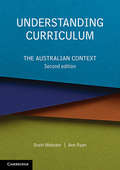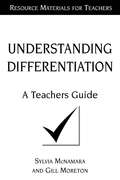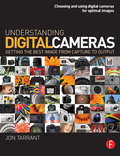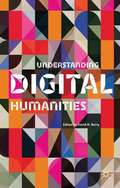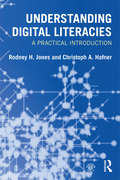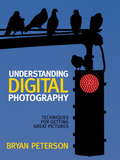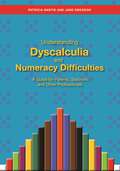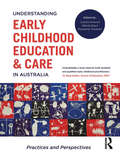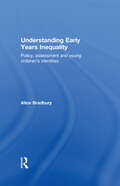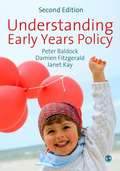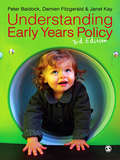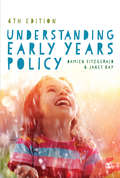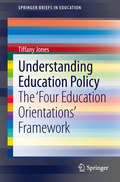- Table View
- List View
Understanding Curriculum
by Scott Webster Ann RyanUnderstanding Curriculum: An Australian Context encourages readers to reflect on how curriculum theory can enhance classroom practice. This book provides a critical introduction to contemporary curriculum theory and practice, outlining both traditional and progressive approaches in order to reconceptualise curriculum. Drawing on a range of perspectives, including behaviourism, constructivism and critical theory, it considers questions of curriculum ownership and culture. It explores technology, gender, equity and diversity, and Indigenous issues in depth. Key principles and debates are brought to life in each chapter through reflective questions and vignettes. Every day, teachers make countless judgements and decisions about the best learning experiences for their students. The authors show how understanding curriculum through different lenses can uncover habits and prejudices that may inhibit good teaching, and can enhance the value of the learning experiences offered to students.
Understanding Curriculum: The Australian Context
by Scott Webster Ann RyanUnderstanding Curriculum is a critical introduction to contemporary curriculum theory and practice. Substantially revised, the second edition includes more detailed consideration of the ideological underpinnings of curriculum development, features new chapters on assessment and reporting, and updated vignettes and extracts. These features, combined with all the elements of the previous edition, encourages readers to reflect on how curriculum theory can inform and enhance classroom practice.
Understanding Design and Technology in Primary Schools: Cases from Teachers' Research
by Les TickleTeaching design and technology to young children has set new challenges for primary school managers, teachers, pupils and parents. Through the use of frank and detailed case studies, this book reveals the teaching aims and methods adopted by teachers, the issues they face in making their work effective, and the experiences of their pupils in learning design and technology. Extensive first hand evidence of classroon experience is provided by the teachers. The collection describes how action research can be done. It then provides practical examples of teachers introducing changes in the curriculum, in their teaching and in their use of evidence in monitoring teaching, as a result of this kind of research. Student teachers, teachers, parents and curriculum managers will all benefit from the insights offered by this wealth of practical accounts.
Understanding Developmental Dyspraxia: A Textbook for Students and Professionals
by Madeleine PortwoodIn this text, the emphasis is placed on the theoretical aspects of developmental dyspraxia, the latest research data and the neurological basis of the condition. The focus is to enable professionals to diagnose the disorder and determine the most appropriate and effective methods of intervention.
Understanding Differentiation: A Teachers Guide
by Sylvia McNamara Gill MoretonIn every classroom there are children of many abilities. Managing the curriculum to meet the needs of all of these children can prove to be time consuming and difficult, as both OFSTED inspection and teacher appraisal observations have shown. This book looks at the many ways that teachers can differentiate work for children whilst keeping their work load manageable. It gives lots of imaginative ideas for activities and worksheets, whole lesson plans and many clearly described examples to help teachers to differentiate work more effectively in their own classrooms. It is a resource book for initial Teacher Training and CPD (Continuing Professional Development); and for senior managers concerned with differentiation either before or after their OFSTED inspection.
Understanding Digital Cameras: Getting the Best Image from Capture to Output
by Jon TarrantUnderstanding Digital Cameras will help you to:* Choose the right camera, lens and output option to capture the perfect image * Develop great technique, whatever your style or subject matter * Be inspired! Showcasing a wide range of images, plus the work and insights of guest photographers This key resource for all photographers will help you get the very best from today's sophisticated digital cameras. Discover which type of camera, lens, lighting and printer is right for you with clear explanations and close-ups of camera settings and menus. A key tool to improve your photography is to see comparison images side by side. Tarrant shoots the same scene with different equipment or a different approach, to show exactly what a camera and technique can or can't do. He also shows you images that haven't worked - and explains precisely why. In this book you will learn essential photographic techniques, before moving on to specific genres: people, nature, action shots and working in the studio. Detailed captions throughout explain which camera and lens was used for each shot and highlight key factors in getting the right exposure, lighting and composition. There is an essential troubleshooting guide to printing errors such as smudges, lines and colour casts. Discover how to produce fine art prints and optimize images for the Web. Plus key technical information on digital and optical quality and colour management.Packed with tips, clear explanations, with all photography terms defined, box outs with key information, and showcasing a wide range of image styles and subjects, this book (and a camera!), is all you need to start creating great images!Jon Tarrant has spent many years as an award-winning professional photographer and much-published photographic writer. He is former editor of the British Journal of Photography, to which he still contributes, and of Professional Photographer and HotShoe International magazines.
Understanding Digital Humanities
by David M. BerryConfronting the digital revolution in academia, this book examines the application of new computational techniques and visualisation technologies in the Arts & Humanities. Uniting differing perspectives, leading and emerging scholars discuss the theoretical and practical challenges that computation raises for these disciplines.
Understanding Digital Literacies: A Practical Introduction
by Rodney H. Jones Christoph A. HafnerAssuming no knowledge of linguistics, Understanding Digital Literacies provides an accessible and timely introduction to new media literacies. It supplies readers with the theoretical and analytical tools with which to explore the linguistic and social impact of a host of new digital literacy practices. Each chapter in the volume covers a different topic, presenting an overview of the major concepts, issues, problems and debates surrounding the topic, while also encouraging students to reflect on and critically evaluate their own language and communication practices. Features include: coverage of a diverse range of digital media texts, tools and practices including blogging, hypertextual organisation, Facebook, Twitter, YouTube, Wikipedia, websites and games an extensive range of examples and case studies to illustrate each topic, such as how blogs have affected our thinking about communication, how the creation and sharing of digital images and video can bring about shifts in social roles, and how the design of multiplayer online games for children can promote different ideologies a variety of discussion questions and mini-ethnographic research projects involving exploration of various patterns of media production and communication between peers, for example in the context of Wikinomics and peer production, social networking and civic participation, and digital literacies at work end of chapter suggestions for further reading and links to key web and video resources a companion website providing supplementary material for each chapter, including summaries of key issues, additional web-based exercises, and links to further resources such as useful websites, articles, videos and blogs. This book will provide a key resource for undergraduate and graduate students studying courses in new media and digital literacies.
Understanding Digital Literacies: A Practical Introduction
by Rodney H. Jones Christoph A. HafnerUnderstanding Digital Literacies Second Edition provides an accessible and timely introduction to new media literacies. This book equips students with the theoretical and analytical tools with which to explore the linguistic dimensions and social impact of a range of digital literacy practices. Each chapter in the volume covers a different topic, presenting an overview of the major concepts, issues, problems, and debates surrounding it, while also encouraging students to reflect on and critically evaluate their own language and communication practices. Features of the second edition include: • expanded coverage of a diverse range of digital media practices that now includes Instagram, Snapchat, TikTok, Tinder, and WhatsApp; • two entirely new chapters on mobility and materiality, and surveillance and privacy; • updated activities in each chapter which engage students in reflecting on and analysing their own media use; • e-resources featuring a glossary of key terms and supplementary material for each chapter, including additional activities and links to useful websites, articles, and videos. This book is an essential textbook for undergraduate and postgraduate students studying courses in new media and digital literacies.
Understanding Digital Photography: Techniques for Getting Great Pictures
by Bryan PetersonUsing his popular bad image/good image pairings of real-life examples, Bryan Peterson takes the reader through all the techniques needed to succeed with digital photography in every popular genre: nature, people, sports, interiors, travel, low-light conditions, travel, weather, commercial portraits, macro, and wildlife--even how to use creative tricks such as reflections. As a bonus, Peterson explains, in straightforward text, the techniques of Photoshop as well as the basics of publishing, printing, and archiving and storing for personal or professional use. Full of great examples for beginners and serious photographers, Understanding Digital Photography makes it easy to create great digital pictures every time.From the Trade Paperback edition.
Understanding Digital Technologies and Young Children: An international perspective
by Susanne Garvis and Narelle LemonUnderstanding Digital Technologies and Young Children explores the possibilities digital technology brings to enhance the learning and developmental needs of young children. Globally, the role of technology is an increasingly important part of everyday life. In many early childhood education frameworks and curricula around the world, there is an expectation that children are developing skills to become effective communicators and are using digital technology to investigate their ideas and represent their thinking. This means that educators throughout the world are expected to actively enhance children’s learning in ways that provide learning experiences with technology that are balanced and purposeful to allow the transformation of traditional authentic learning experiences. Digital technologies can be used to explore, manipulate, discover, play and interact with real and imaginative worlds to allow active meaning making. With a wide range of expert contributors, this book provides a comprehensive examination of the current research on technology and young children and the importance of engagement for learning. This approach encourages the reader to rethink the possibilities and potential of digital technologies for learning in the early years, especially in the years before formal schooling when children might be attending early childhood settings. This will be a valuable reference for anyone looking for an international perspective on digital technology and young children, and is particularly aimed at current and future teachers.
Understanding Dropouts: Statistics, Strategies, and High-Stakes Testing
by Committee on Educational Excellence Testing EquityA report on Statistics, Strategies, and High-Stakes Testing
Understanding Dyscalculia and Numeracy Difficulties: A Guide for Parents, Teachers and Other Professionals
by Jane Emerson Patricia BabtieDyscalculia is a specific learning difficulty that affects the acquisition of numerical skills. A far larger number of pupils, while not dyscalculic, fail to acquire the basic numerical skills required for everyday life. Whatever the cause of poor numeracy it is essential that these difficulties are identified and addressed. This book looks at how adults can help identify each child's specific areas of difficulty and describes a multi-sensory approach that can be adapted for the needs of each student to help them better understand numbers and apply that understanding to solve problems. It covers the origins of number sense and how the brain deals with numbers, assessment, planning intervention, what to teach and how to teach it, and how parents can help their children. This straightforward guide will be essential reading for any parent, teacher or education professional working with a child with dyscalculia or numeracy difficulties.
Understanding EAP Learners’ Beliefs about Language Learning from a Socio-cultural Perspective: A Longitudinal Study at an EMI Context in Mainland China
by Chili LiThis book focuses on the dynamic nature of EAP (English for academic purposes) learners’ beliefs about language learning in their shift from an EFL (English as a foreign language) environment to an EMI (English as the medium of instruction) setting in mainland China. It adopts a mixed method paradigm, whose quantitative part aims to capture the general dynamic feature of the selected student population, while its qualitative part attempts to unveil the process of change in beliefs about language learning among the sample. It is hypothesized that the change in their beliefs about language learning is the result of the interplay between the learners’ agency and the mediation of the contextual realities at the institutional and social levels.
Understanding Early Childhood Education and Care in Australia: Practices and perspectives
by Joanne AilwoodIn order to effectively practise as an early childhood educator it is essential to understand the theories, policies and pedagogy that shape the discipline. Understanding Early Childhood Education and Care in Australia provides core foundational knowledge that is critical for best practice.Part One looks at concepts of childhood and the development of mass education before examining influential theories including developmental psychology, sociology, feminisms and critical theory. Specific approaches are also analysed including Reggio Emilia, Montessori, Multiple Intelligences and HighScope. Part Two focuses on the guiding frameworks and policies in Australia and explores in depth issues affecting Indigenous children and provisions for recognising diversity and the practice of inclusion. The final section examines teaching and leadership and considers curriculum, pedagogy and assessment, building relationships between staff and families, the care of babies and infants, the environment in which early childhood education takes place and the responsibilities and professional development of teachers.This essential reference will ensure pre-service teachers develop a sophisticated understanding of how theory underpins effective practice in early childhood education.
Understanding Early Childhood Mental Health: A Practical Guide For Professionals
by Susan J. Summers Rachel Chazan-Cohen Hiram FitzgeraldAn easily accessible guidebook that presents effective strategies to integrate mental health services in early childhood programs and work in partnership with families to enhance young children's mental health.
Understanding Early Years Education across the UK: Comparing practice in England, Northern Ireland, Scotland and Wales
by Diane Boyd Nicky HirstThe four nations of the UK each have distinctive policy and curricula in relation to Early Childhood Education and Care (ECEC). This new textbook offers a comprehensive look at early years education in England, Northern Ireland, Scotland and Wales, bringing the curriculum frameworks for each country together in one place. Drawing on the cultural and practical pedagogy of each curriculum, this book aims to develop students’ understanding of the development, care, education, health, well-being and upbringing of young children across the UK in a social, pedagogical and policy context. Divided into two sections, the first examines each country’s learning and teaching requirements in detail within a policy context. The book then explores the similarities and differences between the curricula, focusing on key areas such as play, the indoor and outdoor learning environment, the family and assessment. Accessible and engaging, this book will help students to analyse and question practice both in their own country and across all four Home Nations. Features include: case studies to illustrate practice and a frequently asked questions section in each chapter to clarify key points and opportunities for reflection and debate. Including contributions from expert practitioners in each country, this text is essential reading for all students studying early childhood and will help them to understand the impact of policy on children and families across the UK.
Understanding Early Years Inequality: Policy, assessment and young children's identities
by Alice BradburyUnderstanding Early Years Inequality uses critical sociological perspectives to examine the impact of changing assessment policy on primary school classrooms, with a particular focus on issues of inequality. Drawing on accounts of life in early years classrooms, Alice Bradbury suggests that a specific model of the ‘good learner’ operates, and that this model works to exclude some groups of students from positions of educational success. Key themes examined throughout this book relate to: The relationship between assessment policy and children’s identities as learners; The complexity of classroom life; The power of assessment to shape definitions of ‘learning’ and ‘learners’; The impact of discourses of class, race, religion and the ‘inner city’ on how children are assessed, and how assumptions about inner city schools and low attainment can put pressure on teachers to assess children in particular ways. In this important text, the author argues that assessment policies can have a huge impact on classrooms and teachers, as well as having potentially damaging effects for young children, particularly those from minoritised and economically disadvantaged backgrounds. The book explores in detail the complex interaction of education policies with discourses of attainment and expectation, and the resulting reproduction of patterns of inequality. Understanding Early Years Inequality will have an immediate impact on current debates about educational policy and practice in Early Years education, and will be of particular interest to academics and students in educational studies, sociology of education, and early childhood studies.
Understanding Early Years Policy
by Peter Baldock Damien Fitzgerald Janet Kay'This book is a gem! It sets out in a very straightforward and comprehensible way the vast framework of policy which shapes the nature of early years services in the UK today . This book should be on the reading list of all early years practitioners, multi-agency professionals and students as a timely reminder of the context in which they work' - Early Years Update 'This is a fabulous resource, with helpful and practical hints, tips and downloadable electronic resources . A truly invaluable resource for leaders and managers in any early years setting, or for those who are responsible for training members of the children's workforce' - Early Years Educator 'This is an excellent and accessible text which is useful to both practitioners and students. It clearly outlines developments in early years policy in recent years, placing it in its political and social context. The inclusion of policy developments in Scotland, Northern Ireland and Wales in this latest edition gives a new and broader perspective of policy in the United Kingdom than previously available in a single text. Students studying the topic at degree level will find the framework for analyzing the impact of policy particularly enlightening' - Sue O'Neill, Award Director FdA Management of Childcare Provision, Liverpool Hope University 'I predict that this book will quickly find a place on the book lists of colleges and universities around the country' - ESCalate 'This book is excellent. It is very easy to read and it starts with the basics, before allowing the reader to be more reflective' - Michelle Smith, BA (Hons) Early Childhood Studies and Early Years PGCE Covering the latest developments in early years policy, this book explores the processes of how policy is made, implemented, analysed and developed over time. It provides a complete overview of early years policy and evaluates its impact on practice, and it facilitates discussion and critical thinking around policy issues and policy development with the inclusion throughout the book of case studies, points for reflection and activities. There is suggested further reading and a short summary at the end of each chapter, and useful websites are cited. This second edition of a respected book has been substantially revised to include: - a new chapter on policy across England, Scotland, Wales & Northern Ireland - discussion of the new Early Years Foundation Stage - recent developments in Special Educational Needs - a revised and updated timeline of early years legislation - new case studies, covering the Birth to Eight age range - a revised and updated Glossary Suitable for all early years students at all levels, and early years practitioners at any stage of their career, this book is a must-have for navigating the minefield of early years legislation.
Understanding Early Years Policy
by Peter Baldock Damien Fitzgerald Janet KayFully updated to include all the latest developments in early years policy such as the revised Early Years Foundation Stage (EYFS), this book explores how policy is made, implemented, analysed and developed over time. There is a complete overview of early years policy, and an evaluation of its ongoing impact on practice. Case studies, points for reflection and activities encourage discussion and critical thinking. <P><P> This Third Edition has been significantly updated to include:<P> - a new chapter on international early years policy<P> - discussion of the impact of the recession and the Coalition Government's policies<P> - material on how ordinary practitioners can influence policy<P> - a revised timeline of early years legislation.<P> This text is an essential read for early years students at all levels, and early years practitioners.<P> Peter Baldock worked extensively in Early Years education and was chair of the executive committees of two children's chartities based in Sheffield.<P> Damien Fitzgerald and Janet Kay are both Principal Lecturers in Childhood Studies at Sheffield Hallam University.
Understanding Early Years Policy
by Damien Fitzgerald Janet KayPreviously known as Baldock: Understanding Early Years Policy is in its Fourth Edition. This best-selling textbook continues to provide fully updated coverage of all the latest developments in early years policy such as the revised Early Years Foundation Stage (EYFS), SEND Code of Practice 0-25 years and the Children and Families Act 2014. Exploring how policy is made, implemented, analysed and developed over time this book presents a complete overview of early years policy and an evaluation of its ongoing impact on practice. This Fourth Edition has been significantly updated to include: Full coverage of the 2010-2015 UK Coalition Government. A comprehensive timeline of Early Years policy Guidance on how to research policy for yourself More international case studies, now including the US and Scandinavia. New material on how to manage policy changes as a practitioner An expandedfocus of the devolved countries within the UK This text is an essential read for early years students at all levels, and early years practitioners.
Understanding Early Years Policy
by Damien Fitzgerald Janet KayPreviously known as Baldock: Understanding Early Years Policy is in its Fourth Edition. This best-selling textbook continues to provide fully updated coverage of all the latest developments in early years policy such as the revised Early Years Foundation Stage (EYFS), SEND Code of Practice 0-25 years and the Children and Families Act 2014. Exploring how policy is made, implemented, analysed and developed over time this book presents a complete overview of early years policy and an evaluation of its ongoing impact on practice. This Fourth Edition has been significantly updated to include: Full coverage of the 2010-2015 UK Coalition Government. A comprehensive timeline of Early Years policy Guidance on how to research policy for yourself More international case studies, now including the US and Scandinavia. New material on how to manage policy changes as a practitioner An expandedfocus of the devolved countries within the UK This text is an essential read for early years students at all levels, and early years practitioners.
Understanding Education Policy
by Chris RolphFrom academisation and free schools to workforce retention and curriculum change, education policy is a complicated, constantly evolving topic that sits at the heart of any academic study of education. This book offers a critical contextual analysis of education policy and the political ideas that drive policy. It maps a careful journey across the recent policy landscape in England looking at major areas of the education system such as: the curriculum, SEND, pedagogy and the school workforce. Analysis is informed by assessing the real-world impact and implications of government initiatives and by taking into account key contextual issues. Case studies from educational settings, supported by study questions to prompt your thinking, examine how key policy ideas operate in practice. This is the ideal overview of education policy for anyone studying Education Studies degrees at undergraduate level, trainee teachers seeking a deeper understanding of how policy affects the schools they will work in, and Master’s students wanting a clear primer on the subject. Chris Rolph is Director of the Nottingham Institute of Education, Nottingham Trent University.
Understanding Education Policy
by Chris RolphFrom academisation and free schools to workforce retention and curriculum change, education policy is a complicated, constantly evolving topic that sits at the heart of any academic study of education. This book offers a critical contextual analysis of education policy and the political ideas that drive policy. It maps a careful journey across the recent policy landscape in England looking at major areas of the education system such as: the curriculum, SEND, pedagogy and the school workforce. Analysis is informed by assessing the real-world impact and implications of government initiatives and by taking into account key contextual issues. Case studies from educational settings, supported by study questions to prompt your thinking, examine how key policy ideas operate in practice. This is the ideal overview of education policy for anyone studying Education Studies degrees at undergraduate level, trainee teachers seeking a deeper understanding of how policy affects the schools they will work in, and Master’s students wanting a clear primer on the subject. Chris Rolph is Director of the Nottingham Institute of Education, Nottingham Trent University.
Understanding Education Policy
by Tiffany JonesAnalysis of education policy often follows a particular orientation, such as conservative or neo-liberal. Yet, readers are often left to wonder the true meaning and conceptual framing behind these orientations. Without this knowledge, the policy analysis lacks true rigor, its value is diminished as the results may prove difficult to reproduce. Understanding Education Policy provides an overarching framework of four key orientations that lie beneath much policy analysis, yet are rarely used with accuracy: conservative, liberal, critical and post-modern. It details each orientation's application to policy making, implementation and overall impact. The book also argues the value of analysing a policy's orientation to improve the clarity of its analysis and allow broader trends across the education policy field to emerge. The book offers practical examples, key vocabulary and reflection activities which give equitable, yet critical consideration to all education orientations. This allows readers to see the benefits and disadvantages of each perspective and discover their own biases. This introduction to education policy analysis offers theoretically broad, highly practical coverage. It is adaptable to many kinds of policy analysis areas and will appeal to a wide range of readers with an interest in education policy, from students conducting specific research to policy makers looking for a deeper way to re-think their work.

